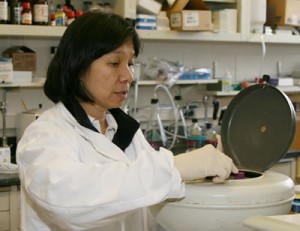
Giving teachers hands-on science experience not only helps improve student achievement, but also reduces teacher attrition, according to results from a Columbia University study.
Of the 145 teachers who completed Columbia University’s Summer Research Program (CUSRP) between 1994 and 2005, 32 New York teachers with similar backgrounds participated in a study to determine if taking part in hands-on science research enabled them to better teach their students.
“Teachers who participated in focused, intensive, and hands-on summer research programs produced a 10 percent increase in the pass rate of their students in New York state science Regents,” said Sam C. Silverstein, who founded the CUSRP and published the results of the study in Science magazine last fall.
“We also saw a three- to four-fold increase in retention compared to the national average for experienced teachers,” he said.
Silverstein said the reduced teacher attrition from classroom teaching leads to a school cost savings of $1.14 for every $1 invested in the program.
“If the program were brought to scale, it would be half as expensive and school systems could potentially save twice as much,” he said.
Better test scores among students of CUSRP teachers could be a result of those teachers’ field experiences, or they could mean those teachers are highly motivated, therefore encouraging their students to perform better in their classes, other researchers cautioned.
“It certainly seems reasonable to expect that teachers who have had research experiences are more effective than teachers who have not had such experiences. I am not sure, however, whether the research experiences make the teachers better, or if the more effective teachers are more likely to seek out research experiences in the first place. I expect that it is a little of both,” said David S. Hibbett, professor and interim chair of the biology department at Clark University in Massachusetts.
But Silverstein noted that in the year preceding a teacher’s entry to CUSRP, there were no significant differences in New York’s state science exam performance between participating and non-participating teachers’ students.
“This finding suggests that although teacher motivation probably contributes to their students’ improved achievement, it does not predestine this outcome,” he wrote. “The evidence suggests that the program’s impact on teachers drives the improvements in student science achievement.”
The percentage of their students passing the Regents test in biology, chemistry, and earth science was greater for teachers who took part in CUSRP than it was for teachers who did not participate in the program. The student pass rate for participating teachers also was higher after they experienced the program than it was before they took part.
“We compared pass rates on Regents biology, chemistry, and earth science exams of 7,209 students of CUSRP teachers with those of 36,101 students who studied the same subject at the same time and in the same schools in classes of non-CUSRP teachers as a quantitative measure of the impact of teacher participation in CUSRP on student achievement,” Silverstein wrote in the Science article.
In CUSRP, 10 to 13 middle- and high-school science teachers are selected to partner with a Columbia faculty member who is working on an area of interest to that teacher. Teachers and faculty members spend one day each week for two summers on professional development exercises, including lab and field work.
“The teacher becomes a member of the faculty member’s research team,” Silverstein said. “He or she participates fully in the work of the lab.”
In the study, CUSRP teachers said the stresses they experienced in adapting to a research laboratory increased their appreciation of the students’ difficulties and prompted them to respond with more sympathy.
“Many teachers tell us that when they get back to their school, they stop saying, ‘That’s right,’ or, ‘That’s wrong,’ but instead ask the student, ‘Why do you think that?’” Silverstein said. “The program develops an inquiring mode of thinking.”
Melissa Diggins, a fifth-grade teacher at Anasazi Elementary in Arizona, participated in NASA’s space camp last summer, prompting her and another teacher to create their own space camp at Anasazi.
“I got a broader sense of understanding [science, technology, engineering, and math] and its importance,” she said. “So I was able to give students hands-on experience, as well as higher-level thinking skills.”
Diggins created an eight-week after-school program for fourth and fifth graders that was so successful, she is now looking at creating two sessions next year—one for kindergarten through second graders and another for third through fifth graders.
“I saw the students getting excited about science, and I was able to foster their love for science,” she said. “Many students came in without knowing how they felt about science and left wanting to pursue careers in STEM fields.”
Link:
Columbia University’s Summer Research Program
- 3D equipment helps school lessons take on a whole new dimension - September 3, 2010
- IETF: AT&T’s net neutrality claim is ‘misleading’ - September 3, 2010
- To boost security, Facebook adds remote logout - September 3, 2010


Comments are closed.